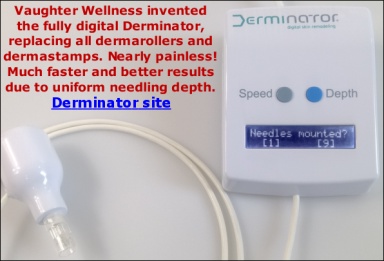We started to receive some positive feedback on our "special" vitamin A & D ointment Infadolan. (Read about Infadolan's ingredients in our web store) I tried to find another one that mentioned how there was absolutely no irritation but instead a cool, soothing feeling, but I couldn't find it in my inbox any more.
<strong><span style="font-family: Courier New;">Hi Sarah,</span></strong>
<strong><span style="font-family: Courier New;">I received my Dermaroller in January and have used it once. I'm looking forward to seeing results, with continued use and time.</span></strong>
<strong><span style="font-family: Courier New;">I had to write to you today, to share a big *WOW* about something unexpected - the Infadolan cream. After just one use, I noticed that my undereye lines and creases were markedly improved. </span></strong>
<strong><span style="font-family: Courier New;">I'm in my early 40s with fair and very dry skin. I think my skin is in good condition overall. (Eye lines and crosshatched skin when smiling are the only trouble spots.) I've never found a product that works half as well as the Infadolan. Now I used it at night on a regular basis and each morning I awaken to smooth, youthful skin in the undereye area. </span></strong>
<strong><span style="font-family: Courier New;">Thank you so much for this unexpected discovery.</span></strong>
<strong><span style="font-family: Courier New;">PS - I'm very happy with the Dermaroller, too.

</span></strong> <span style="font-family: Verdana;"><span style="font-size: 12px;">That's great to hear!</span></span>
<span style="font-family: Verdana;"><span style="font-size: 12px;">You should benefit from the vit. A at the very least.</span></span>
<span style="font-family: Verdana;"><span style="font-size: 12px;">Do you run into issues with greasiness?</span></span>
<span style="font-family: Verdana;"><span style="font-size: 12px;">
</span></span>
<strong><span style="font-family: Courier New;"><span style="font-size: 12px;">>It is greasy, but I don't use much and I only apply it at night, so it is not a problem. And when I weigh the greasiness against the positive effects, it is so worth using!!
>In the states, emu oil is all the rage. I tried it last year and it was at least as oil as the Infadolan. Emu didn't seem to sink into my skin, though, and I didn't notice
>any improvement from it.
>I hadn't expected the Infadolan to make any visible difference. I checked some of the skincare forums on the web (which is how I found you) and none of them had any comments
>like what I have experienced.
>I'm going to have my mom use it next. : )
>Thanks again from a very grateful customer.
</span></span></strong><span style="font-family: Courier New;"><span style="font-size: 12px;">
H.B. from the UK</span></span><span style="font-family: Verdana;"><span style="font-size: 12px;"> emailed us this on March 11, 2010:</span></span><strong><span style="font-family: Courier New;"><span style="font-size: 12px;">
>p.s.
</span></span></strong> <span style="font-family: Courier New;"><span style="font-size: 12px;"><strong>>I was very impressed with the infadolan ointment, and your sensible consiseration of an alchohol/irritant/paraben free ointment.
>I previously had dermaroller treatment from a professional who gave me Chiroxy cream to apply afterwards.
>This left my skin dry/irritated and peeling. The infadolan is soothing and I had no peeling at all after my second dermaroll.</strong></span></span>





